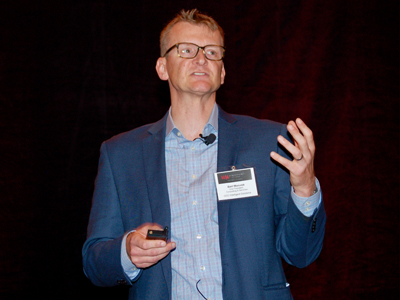One trend not expected to end in 2023: the rapid rise in average repair costs.
That was among the messages Bart Mazurek of CCC Intelligent Solutions shared during the MSO Symposium in November in Las Vegas.
“If we look at 2018, the average repair cost was about $3,000,” said Mazurek, vice president of consulting services for CCC. “Now we’re looking at just north of $4,000. And given inflationary trends, I anticipate that number being around $4,400 or $4,500 [in 2023].”
He cited among the causes the rise in the average number of parts being replaced per repair job.
“In just a two-year span, we’ve gone from 10.5 parts to almost 12.5 parts,” he said. “And those two additional parts are driving four additional hours of labor.”
He noted a bumper for a 1996 Honda Accord consisted of about 11 components, but the current model Accord bumper includes more than 20. More of those parts, such as ADAS sensors, are not repairable and are available only through the automakers.
He said the OEM share of average parts costs had been “rather steady for years,” but in 2022, it “really jumped up because the OEMs are the only ones that can supply those additional two parts per job.”
CCC’s data seems to indicate the increase in the average repair order isn’t being dramatically impacted by a significant increase in shop labor rates.
“Labor rates have only gone up $1 this year compared to last year,” Mazurek said, noting he was speaking only of work processed through insurer direct repair programs (DRPs). “It’s continuing to rise, but it’s a slow process.”
He shared a graph indicating the growth in the national average labor rate has lagged below the consumer price index (CPI) for “motor vehicle maintenance and repair in U.S. cities” since late 2018, but the difference has become increasingly stark in 2022, with that CPI growth far outpacing increases in labor rates.
Shops Have Fewer DRPs
The slow growth in DRP labor rates could be contributing to another trend Mazurek reported: Shops have fewer DRP agreements on average than they have in the past. Across all business models---single-location, dealership and MSOs---shops averaged 4.6 DRPs in 2022, according to CCC data, down from an average of 5.2 in 2021, more than an 11% decline.
Breaking it down by shop type, dealership collision shops fell from 6.3 DRPs to 5.8; regional MSOs fell more than 6% to an average of 5.6 per shop; and independent shops dropped from 3.1 to 2.8 DRPs on average---more than a 9% decline.
But the trend among the national MSOs is even more stark. They averaged 12.3 DRPs per location in 2020, but that’s fallen two years in a row to reach an average of 10.2 in 2022, down 17% over two years.
“I think that has to do with repair facilities reevaluating DRPs based on the current market and their goals,” Mazurek said. “And they decided to reduce the number of DRP programs to better align with their goals.”
Continued Decline in ‘Hours Per Day’
The downward trend in labor hours produced per repair day that has been occurring since 2017 also continued in 2022, Mazurek said. Looking at second quarter data over six years, shops were producing about 3.5 labor hours per day on drivable vehicles until 2020; that fell to 2.8 hours per day in 2020, and fell again, to 2.3 hours per day in 2022. That’s a 34% decline.
There was even a bit steeper decline---about 38%---for non-drivable vehicles, down to 1.8 hours per day in 2022 from between 2.8 and 3 hours per day in 2017 through 2020.
Mazurek said some of that decline could be because of overloaded shops having to spend more time shuffling cars around, because of backlogs and part delays, rather than a technician working steadily on one or two cars start to finish. He doesn’t expect those factors to diminish before mid-2023 at the earliest.
Mazurek also said he has “a hypothesis that I can’t prove yet” that when shop backlogs of work were two weeks or less, “the competitive nature of technicians, working next to his or her peer, wants the next car,” seeing the potential end of the line of that work.
“But if you have five or six or seven weeks of vehicles stacked endlessly, it’s effectively guaranteed work forever,” Mazurek said. “So there’s no real rush. I’d love to be able to prove that, but I feel strongly that there’s this lack of urgency overall amongst technicians.”















John Yoswick